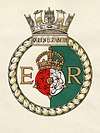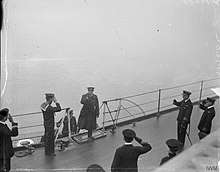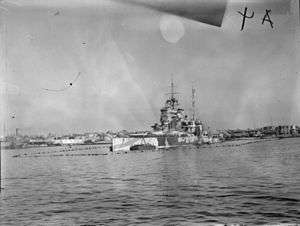HMS Queen Elizabeth (1913)
_(cropped).jpg) Queen Elizabeth, 1936 | |
| History | |
|---|---|
| Name: | Queen Elizabeth |
| Namesake: | Elizabeth I |
| Builder: | Portsmouth Royal Dockyard |
| Cost: | £3,014,103 |
| Laid down: | 21 October 1912 |
| Launched: | 16 October 1913 |
| Completed: | January 1914 |
| Commissioned: | 22 December 1914 |
| Decommissioned: | 1948 |
| Struck: | 7 July 1948 |
| Identification: | Pennant number: 00 |
| Fate: | Sold to Arnott Young and scrapped in Dalmuir, Scotland |
| Badge: |
 |
| General characteristics (as built) | |
| Class and type: | Queen Elizabeth-class battleship |
| Displacement: |
|
| Length: | 643 ft 9 in (196.2 m) |
| Beam: | 90 ft 7 in (27.6 m) |
| Draught: | 33 ft (10.1 m) |
| Installed power: |
|
| Propulsion: |
|
| Speed: | 24 knots (44 km/h; 28 mph) |
| Range: | 5,000 nmi (9,260 km; 5,750 mi) at 12 knots (22 km/h; 14 mph) |
| Complement: | 1,262 (1920, as a flagship) |
| Armament: |
|
| Armour: |
|
HMS Queen Elizabeth was the lead ship of her class of dreadnought battleships built for the Royal Navy in the early 1910s, and was often used as a flagship. She served in the First World War as part of the Grand Fleet, and participated in the inconclusive Action of 19 August 1916. Her service during the war generally consisted of routine patrols and training in the North Sea. She and the other super-dreadnought battleships were the first of their type to be powered by oil instead of coal. Queen Elizabeth later served in several theatres during the Second World War, and was ultimately scrapped in 1948.
Design and description
The Queen Elizabeth-class ships were designed to form a fast squadron for the fleet that was intended to operate against the leading ships of the opposing battleline. This required maximum offensive power and a speed several knots faster than any other battleship to allow them to defeat any type of ship.[1][2]
Queen Elizabeth had a length overall of 643 feet 9 inches (196.2 m), a beam of 90 feet 7 inches (27.6 m) and a deep draught of 33 feet (10.1 m). She had a normal displacement of 32,590 long tons (33,110 t) and displaced 33,260 long tons (33,794 t) at deep load. She was powered by two sets of Brown-Curtis steam turbines, each driving two shafts, using steam from 24 Yarrow boilers. The turbines were rated at 75,000 shp (56,000 kW) and intended to reach a maximum speed of 24 knots (44.4 km/h; 27.6 mph). Queen Elizabeth had a range of 5,000 nautical miles (9,260 km; 5,754 mi) at a cruising speed of 12 knots (22.2 km/h; 13.8 mph). Her crew numbered 1,262 officers and ratings in 1920 while serving as a flagship.[3]
The Queen Elizabeth class was equipped with eight breech-loading (BL) 15-inch (381 mm) Mk I guns in four twin gun turrets, in two superfiring pairs fore and aft of the superstructure, designated 'A', 'B', 'X', and 'Y' from front to rear. Queen Elizabeth was the only ship of her class that mounted all sixteen of the designed BL 6-inch (152 mm) Mk XII guns in casemates. Twelve of these were mounted along the broadside of the vessel amidships and the remaining four were grouped in the stern abreast 'X' and 'Y' turrets. These latter guns were quickly found to be too close to the water and were frequently flooded at high speed or heavy seas. Two were removed and the other pair were shifted to positions on the forecastle deck near the aft funnel, protected by gun shields, in May 1915. The ships' anti-aircraft (AA) armament consisted of two quick-firing (QF) 3-inch (76 mm) 20 cwt Mk I[Note 1] guns. They were fitted with four submerged 21 inch (533 mm) torpedo tubes, two on each broadside.[4]
Queen Elizabeth was completed with two fire-control directors fitted with 15-foot (4.6 m) rangefinders. One was mounted above the conning tower, protected by an armoured hood, and the other was in the spotting top above the tripod foremast. Each turret was also fitted with a 15-foot rangefinder. The main armament could be controlled by 'B' turret as well. The secondary armament was primarily controlled by directors mounted on each side of the compass platform on the foremast once they were fitted in March 1917, although one temporary director was fitted in November–December 1916.[5]
The waterline belt of the Queen Elizabeth class consisted of Krupp cemented armour (KC) that was 13 inches (330 mm) thick over the ships' vitals. The gun turrets were protected by 11 to 13 inches (279 to 330 mm) of KC armour and were supported by barbettes 7–10 inches (178–254 mm) thick. The ships had multiple armoured decks that ranged from 1 to 3 inches (25 to 76 mm) in thickness. The main conning tower was protected by 13 inches of armour. After the Battle of Jutland, 1 inch of high-tensile steel was added to the main deck over the magazines and additional anti-flash equipment was added in the magazines.[6]
Construction and career


Queen Elizabeth, named in honour of Elizabeth I of England, was launched on 16 October 1913 at Portsmouth, Hampshire, and entered service in January 1915 during the First World War. While still undergoing testing in the Mediterranean, the ship was sent to the Dardanelles for the Allied attempt to knock the Ottoman Empire out of the war. She was the only dreadnought battleship to participate, though a number of battlecruisers and pre-dreadnought battleships were also involved. She became the flagship for the preliminary naval operations in the Dardanelles Campaign, leading the first line of British battleships in the battle of 18 March 1915. During the attempted military invasion of the Gallipoli on 25 April, Queen Elizabeth was the flagship for General Sir Ian Hamilton, commander of the Mediterranean Expeditionary Force. However, after the sinking of HMS Goliath by a Turkish destroyer on 12 May, Queen Elizabeth was immediately withdrawn to a safer position.
She joined Admiral Hugh Evan-Thomas's 5th Battle Squadron (consisting of Queen Elizabeth-class battleships) of the Grand Fleet based at Scapa Flow, but she missed the Battle of Jutland due to being in dock for maintenance. HMS Queen Elizabeth became the Grand Fleet Flagship on Admiral Sir David Beatty’s appointment as Admiral of the Fleet 1917 and saw the German High Seas Fleet internment at Scapa Flow at the end of the First World War.
Interwar period

Between the wars she was the flagship of the Atlantic Fleet from 1919 to 1924. The future First Sea Lord John H. D. Cunningham served aboard her as Master of the Fleet, in 1922. From 1924 she was the flagship of the Mediterranean Fleet. Following a refit, she rejoined the Mediterranean Fleet in 1927, went to the Atlantic Fleet in 1929, and later that year returned to the Mediterranean, where she served until 1937.[7] During the 1930s she participated in the non-intervention blockade during the Spanish Civil War.
She was rebuilt twice between the world wars; in 1926–1927 bulges were added, the funnels were trunked, four 4 inch guns were added, and a new foretop was installed. In her 1937–1941 rebuild she was fitted with a tower bridge in place of her old bridge; her 6-inch (152 mm) guns were removed and replaced by 20 (10 × 2) 4.5 in (114 mm) guns in ten double turrets and several smaller anti-aircraft guns; horizontal armour was added; engines and boilers were replaced; and the elevation of her main battery was increased to 30 degrees. Deck armour was increased to 5 inches over the magazines, 2.5 inches over the machinery, while the new 4.5" guns had between 1 and 2 inches of armour.[8] She also received facilities for aircraft with a launching catapult amidships.[7] New fire control equipment was installed, including the HACS MkIV AA fire control system and the Admiralty Fire Control Table Mk VII for surface fire control of the main armament. This reconstruction was completed in January 1941, when Britain had been at war for over a year.
Second World War

When her reconstruction was complete, Queen Elizabeth rejoined the Mediterranean Fleet, covering the evacuation of Crete in June 1941.[7] She, along with HMS Valiant, was mined and seriously damaged by Italian frogmen (Antonio Marceglia and Spartaco Schergat), operating human torpedo craft in a attack on 19 December 1941 in shallow water in the harbour at Alexandria, Egypt, with the loss of nine men of her complement.
Although badly damaged, with her draught increased to 41.8 feet (12.5m), Queen Elizabeth was not grounded on the harbour bottom,[9][10] her decks were clear and the Italian crews were captured. For this reason, the British maintained the illusion of full operational status, to conceal the weak British position in the Mediterranean during the period the two ships were patched and refloated. However, this concealing action lasted through a few days only. The Valiant went back into service after many months and the Queen Elizabeth after more than a year and half. Following completion of temporary repairs in an Alexandria drydock in June 1942, she steamed through the Suez Canal and around Africa to the Navy Yard in Norfolk, Virginia in the United States. From September of that year until June 1943, she was comprehensively repaired.
Queen Elizabeth went to the Home Fleet in July 1943, and in December 1943 she left for the Eastern Fleet, which she joined in January 1944 [11] (in November 1944 reorganized into the East Indies Fleet)[12]. She took part in raids on Japanese bases in the Dutch East Indies, and was placed in reserve in August 1945.
The vessel was paid off in June and scrapped in July 1948.[7]
A model of HMS Queen Elizabeth by Norman A. Ough is held by the National Maritime Museum.[13]
Notes
- ↑ "Cwt" is the abbreviation for hundredweight, 20 cwt referring to the weight of the gun.
Citations
- ↑ Burt 1986, p. 251
- ↑ Parkes, pp. 560–61
- ↑ Burt 1986, pp. 255, 257–58, 261
- ↑ Burt 1986, pp. 252–53, 256–57
- ↑ Raven & Roberts, p. 20–21, 30
- ↑ Raven & Roberts, pp. 21, 26
- 1 2 3 4 Lyon, Hugh; Moore, John E. The Encyclopedia of the World's Warships. London: Salamander Books. pp. 32–33. ISBN 0-517-22478-X.
- ↑ Raven and Roberts, British Battleships of WW2, p247
- ↑ Burt, R. A. (2012). British Battleships 1919–1945. Annapolis: Naval Institute Press. ISBN 9781591140528, pp.120-121: "Prior to the attack Queen Elizabeth had a draught of 33ft 5in forward and 32ft 7in aft; after the explosion: draught 41ft 10in forward, 33ft 10in aft." Queen Elizabeth was moored in approximately 48ft (8 fathoms) of water.
- ↑ Brown, David (2002). The Royal Navy and the Mediterranean: November 1940 - December 1941, Volume II. Routledge, ISBN 0-7146-5205-9, p. 225.
- ↑ http://www.wlb-stuttgart.de/seekrieg/44-01.htm#11-3101
- ↑ http://www.wlb-stuttgart.de/seekrieg/44-11.htm
- ↑ "Norman Ough's HMS Queen Elizabeth". Royal Museums Greenwich.
References
- Admiralty Historical Section (2002). The Royal Navy and the Mediterranean. Whitehall histories., Naval Staff histories. Vol. 2, November 1940–December 1941. London: Whitehall History in association with Frank Cass. ISBN 0-7146-5205-9.
- Brooks, John (2005). Dreadnought Gunnery and the Battle of Jutland. London: Routledge. ISBN 978-0-7146-5702-8.
- Burt, R. A. (2012). British Battleships, 1919–1939 (2nd ed.). Annapolis, Maryland: Naval Institute Press. ISBN 978-1-59114-052-8.
- Burt, R. A. (1986). British Battleships of World War One. Annapolis, Maryland: Naval Institute Press. ISBN 0-87021-863-8.
- Campbell, John (1972). Queen Elizabeth Class. Warship Monographs. 2. London: Conway Maritime Press. ISBN 0-85177-052-5.
- Campbell, N. J. M. (1986). Jutland: An Analysis of the Fighting. Annapolis, Maryland: Naval Institute Press. ISBN 0-87021-324-5.
- Chesneau, Roger, ed. (1980). Conway's All the World's Fighting Ships 1922–1946. Greenwich, UK: Conway Maritime Press. ISBN 0-85177-146-7.
- Director of Naval Construction (1952). H.M. Ships Damaged or Sunk by Enemy Action, 1939-1945 (PDF). Britain: Admiralty.
- Gardiner, Robert & Gray, Randal, eds. (1984). Conway's All the World's Fighting Ships: 1906–1921. Annapolis: Naval Institute Press. ISBN 0-87021-907-3.
- Gordon, Andrew (2012). The Rules of the Game: Jutland and British Naval Command. Annapolis, Maryland: Naval Institute Press. ISBN 978-1-59114-336-9.
- Jellicoe, John (1919). The Grand Fleet, 1914–1916: Its Creation, Development, and Work. New York: George H. Doran Company. OCLC 13614571.
- Massie, Robert K. (2003). Castles of Steel: Britain, Germany, and the Winning of the Great War at Sea. New York: Random House. ISBN 0-679-45671-6.
- Parkes, Oscar (1990). British Battleships (reprint of the 1957 ed.). Annapolis, Maryland: Naval Institute Press. ISBN 1-55750-075-4.
- Raven, Alan & Roberts, John (1976). British Battleships of World War Two: The Development and Technical History of the Royal Navy's Battleship and Battlecruisers from 1911 to 1946. Annapolis, Maryland: Naval Institute Press. ISBN 0-87021-817-4.
- Rohwer, Jürgen (2005). Chronology of the War at Sea 1939-1945: The Naval History of World War Two (Third Revised ed.). Annapolis, Maryland: Naval Institute Press. ISBN 1-59114-119-2.
- Shores, Christopher; Cull, Brian & Malizia, Nicola (1987). Air War for Yugoslavia, Greece, and Crete. London: Grub Street. ISBN 0-948817-07-0.
- Silverstone, Paul H. (1984). Directory of the World's Capital Ships. New York: Hippocrene Books. ISBN 0-88254-979-0.
- Tarrant, V. E. (1999). Jutland: The German Perspective: A New View of the Great Battle, 31 May 1916 (reprint of the 1995 ed.). London: Brockhampton Press. ISBN 1-86019-917-8.
- Whitley, M. J. (1999). Battleships of World War Two: An International Encyclopedia. Annapolis, Maryland: Naval Institute Press. ISBN 1-55750-184-X.
External links
| Wikimedia Commons has media related to HMS Queen Elizabeth. |
- Royal Navy History HMS Queen Elizabeth loading cordite and shells for firing.
- Maritimequest HMS Queen Elizabeth Photo Gallery
- HMS Queen Elizabeth at navalhistories
- IWM Interview with Geoffrey Norman, who commanded HMS Queen Elizabeth from 1943 to 1945